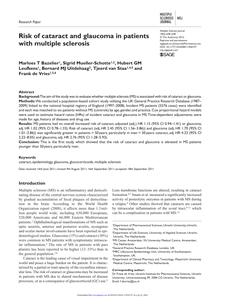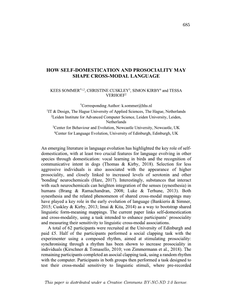Plastic is one of the biggest contributors to pollution of the planet. Due to the low recyclability of oil-based plastics, most plastic is being disposed into the environment. According to plastic oceans, 10 million tons of plastic are dumped into oceans annually. Currently, researchers are developing recycling methods for oil-based plastics and are looking for biobased alternatives. One of these alternatives are a class of polymers called polyhydroxyalkanoates (PHA’s). PHA’s differ from other biobased polymers, due to the process of fabrication. PHA’s are a natural polymer, acting as an energy and carbon storage for different strains of bacteria. Functioning as an energy storage, nature can break down PHA’s and PHA-based waste. (1) Different companies are working on PHA’s production, but a large deviations in physical properties were observed. This research aims to establish a relationship between the chemical and physical properties of the different PHA’s, using gel permeability chromatography (GPC), nuclear magnetic resonance (NMR) and gas chromatography-mass spectroscopy (GC-MS).
DOCUMENT
Fingerprints are widely used in forensic science for individualization purposes. However, not every fingermark found at a crime scene is suitable for comparison, for instance due to distortion of ridge detail, or when the reference fingerprint is not in the database. To still retrieve information from these fingermarks, several studies have been initiated into the chemical composition of fingermarks, which is believed to be influenced by several donor traits. Yet, it is still unclear what donor information can be retrieved from the composition of one's fingerprint, mainly because of limited sample sizes and the focus on analytical method development. It this paper, we analyzed the chemical composition of 1852 fingerprints, donated by 463 donors during the Dutch music festival Lowlands in 2016. In a targeted approach we compared amino acid and lipid profiles obtained from different types of fingerprints. We found a large inter-variability in both amino acid and lipid content, and significant differences in L-(iso)leucine, L-phenylalanine and palmitoleic acid levels between male and female donors. In an untargeted approach we used full-scan MS data to generate classification models to predict gender (77.9% accuracy) and smoking habit (90.4% accuracy) of fingerprint donors. In the latter, putatively, nicotine and cotinine are used as predictors.
MULTIFILE

Numerous medical studies have shown the positive effects of forests on different aspects of human health. This study deals with the content of major terpenes in dominant coniferous species in Tara National Park, Serbia, in order to explore the potential for the development of a novel health tourism programme based on forest therapy. Main terpenes were analysed using a headspace-sam-pling technique coupled with gas-chromatography-mass spectrometry (Head-space-GC/MS). Nee-dles of fir and spruce growing in the vicinity of hiking trails were investigated for possibilities to perform such therapy. Major detected terpenes were α-cadinol and spathulenol previously de-scribed as antiviral, antitumor, antimicrobial and immunomodulatory agents. The results of the study were favourable and worked well with the existing walking infrastructure in the observed area of the Tara Mountain, as they act as invaluable resources for designing the structured forest bathing walks. The study not only adds to the knowledge in the environmental and public health realm but also to tourism and sustainability studies.
MULTIFILE
Glycerol is an attractive bio-based platform chemical that can be converted to a variety of bio-based chemicals. We here report a catalytic co-conversion strategy where glycerol in combination with a second (bio-)feed (fatty acids, alcohols, alkanes) is used for the production of bio-based aromatics (BTX). Experiments were performed in a fixed bed reactor (10 g catalyst loading and WHSV of (co-)feed of 1 h-1) at 550 °C using a technical H-ZSM-5/Al2O3 catalyst. Synergistic effects of the co-feeding on the peak BTX carbon yield, product selectivity, total BTX productivity, catalyst life-time, and catalyst regenerability were observed and quantified. Best results were obtained for the co-conversion of glycerol and oleic acid (45/55 wt%), showing a peak BTX carbon yield of 26.7 C%. The distribution of C and H of the individual co-feeds in the BTX product was investigated using an integrated fast pyrolysis-GC-Orbitrap MS unit, showing that the aromatics are formed from both glycerol and the co-feed. The results of this study may be used to develop optimized co-feeding strategies for BTX formation. This journal is
DOCUMENT
The aim of the study was to evaluate whether multiple sclerosis (MS) is associated with risk of cataract or glaucoma. We conducted a population-based cohort study utilizing the UK General Practice Research Database (1987–2009) linked to the national hospital registry of England (1997–2008). Incident MS patients (5576 cases) were identified and each was matched to six patients without MS (controls) by age, gender, and practice. Cox proportional hazard models were used to estimate hazard ratios (HRs) of incident cataract and glaucoma in MS. Time-dependent adjustments were made for age, history of diseases and drug use.
DOCUMENT

Gedragsveranderende gezondheidscommunicatie is voor veel communicatieprofessionals een uitdaging. Ontwikkelingen op het gebied van interactieve media kunnen hierbij een doorslaggevende rol spelen. De gezondheidsprofessional krijgt hierdoor nieuw gereedschap in handen. In dit artikel wordt uiteengezet hoe interactieve media strategisch kunnen worden ingezet ten einde de effectiviteit te vergroten van een drietal belangrijke ommunicatiestrategieën: inhaken op het kritieke moment, voelbaar maken van sociale druk en afstemming op het individu.
DOCUMENT

This paper links self-domestication and cross-modality, using a task intended to enhance participants’ prosociality and measuring their sensitivity to linguistic cross-modal associations.
DOCUMENT

Using stable isotope techniques, this study shows that plasma free fatty acid oxidation is not impaired during exercise in non-obese type II diabetic patients.
DOCUMENT

From Springer description: "We present the design considerations of an autonomous wireless sensor and discuss the fabrication and testing of the various components including the energy harvester, the active sensing devices and the power management and sensor interface circuits. A common materials platform, namely, nanowires, enables us to fabricate state-of-the-art components at reduced volume and show chemical sensing within the available energy budget. We demonstrate a photovoltaic mini-module made of silicon nanowire solar cells, each of 0.5 mm2 area, which delivers a power of 260 μW and an open circuit voltage of 2 V at one sun illumination. Using nanowire platforms two sensing applications are presented. Combining functionalised suspended Si nanowires with a novel microfluidic fluid delivery system, fully integrated microfluidic–sensor devices are examined as sensors for streptavidin and pH, whereas, using a microchip modified with Pd nanowires provides a power efficient and fast early hydrogen gas detection method. Finally, an ultra-low power, efficient solar energy harvesting and sensing microsystem augmented with a 6 mAh rechargeable battery allows for less than 20 μW power consumption and 425 h sensor operation even without energy harvesting."
LINK
Light enables us to see and perceive our environment but it also initiates effects beyond vision, such as alertness. Literature describes that at least six factors are relevant for initiating effects beyond vision. The exact relationship between these factors and alertness is not yet fully understood. In the current field study, personal lighting conditions of 62 Dutch office workers (aged 49.7 ± 11.4 years) were continuously measured and simultaneously self-reported activities and locations during the day were gathered via diaries. Each office worker participated 10 working days in spring 2017. Personal lighting conditions were interpreted based on four of the six factors (light quantity, spectrum, timing, and duration of light exposure). Large individual differences were found for the daily luminous exposures, illuminances, correlated colour temperatures, and irradiances measured with the blue sensor area of the dosimeter. The average illuminance (over all participants and all days) over the course of the day peaked three times. The analysis of the duration of light exposure demonstrated that the participants were on average only exposed to an illuminance above 1000 lx for 72 minutes per day. The interpretation of personal lighting conditions based on the four factors provides essential information since all of these factors may be relevant for initiating effects beyond vision. The findings in the current paper give first in-depth insight in the possibilities to interpret personal lighting conditions of office workers.
MULTIFILE
